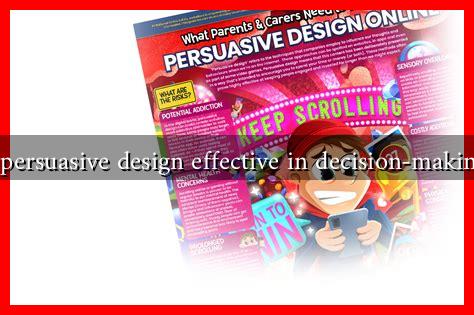-
Table of Contents
Is Persuasive Design Effective in Decision-Making?
In an increasingly digital world, the design of websites, applications, and products plays a crucial role in influencing user behavior. Persuasive design, a concept that integrates psychology and design principles, aims to guide users toward specific actions or decisions. But how effective is persuasive design in decision-making? This article explores the principles of persuasive design, its effectiveness, and real-world examples that illustrate its impact.
Understanding Persuasive Design
Persuasive design refers to the strategic use of design elements to influence user behavior and decision-making. It leverages psychological principles to create experiences that encourage users to take specific actions, such as making a purchase, signing up for a newsletter, or sharing content on social media. Key principles of persuasive design include:
- Reciprocity: Users are more likely to take action if they feel they are receiving something in return.
- Scarcity: Limited availability can create urgency, prompting users to act quickly.
- Social Proof: People tend to follow the actions of others, especially in uncertain situations.
- Authority: Users are more likely to trust and follow recommendations from credible sources.
- Consistency: Once users commit to a small action, they are more likely to agree to larger requests.
The Effectiveness of Persuasive Design
Research indicates that persuasive design can significantly impact decision-making. A study published in the journal Computers in Human Behavior found that websites employing persuasive design techniques led to higher conversion rates compared to those that did not. Here are some key findings:
- Websites that utilized social proof, such as customer reviews and testimonials, saw a 12% increase in conversion rates.
- Scarcity tactics, like countdown timers for limited-time offers, resulted in a 20% increase in sales.
- Personalized recommendations based on user behavior led to a 15% increase in average order value.
Real-World Examples of Persuasive Design
Several companies have successfully implemented persuasive design to enhance decision-making among their users. Here are a few notable examples:
- Amazon: The e-commerce giant uses scarcity by displaying limited stock notifications and countdown timers for deals, creating a sense of urgency that encourages users to make quick decisions.
- Netflix: By showcasing popular shows and movies that are trending among users, Netflix employs social proof to influence viewing choices, making users more likely to watch content that others enjoy.
- Airbnb: The platform uses personalized recommendations based on previous searches and bookings, enhancing user experience and increasing the likelihood of booking accommodations.
Challenges and Ethical Considerations
While persuasive design can be effective, it also raises ethical concerns. Manipulative tactics can lead to user frustration and distrust if they feel coerced into making decisions. Therefore, it is essential for designers to balance persuasive techniques with transparency and user autonomy. Ethical persuasive design should:
- Prioritize user well-being and satisfaction.
- Provide clear information about the consequences of decisions.
- Allow users to opt-out of persuasive tactics if they choose.
Conclusion
Persuasive design is a powerful tool in influencing decision-making, as evidenced by numerous studies and real-world applications. By understanding and applying psychological principles, designers can create experiences that guide users toward desired actions. However, it is crucial to approach persuasive design ethically, ensuring that users feel empowered rather than manipulated. As technology continues to evolve, the role of persuasive design in decision-making will likely grow, making it essential for designers to remain mindful of their impact on user behavior.
In summary, persuasive design is effective in decision-making when used responsibly, balancing influence with user autonomy. By leveraging principles such as reciprocity, scarcity, and social proof, businesses can enhance user engagement and drive conversions while maintaining ethical standards.

